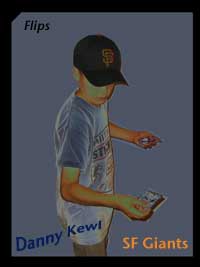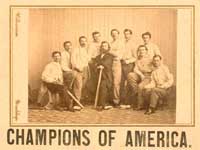
Click for bigger picture
There are three particularly popular baseball card games, descriptively named for the type of play involved. They include flip, toss and colors.
There are certain skills that you might spend scores of hours perfecting in childhood, which are totally meaningless when you grow up. Flipping cards was once on of the top of the list, a critical childhood skill that has no place in the world of adults. It is an activity that can be done by anyone, but to be done well requires finesse and a truly subtle touch.
Rules are simple; from a standing position, the first player takes a card, holds it along his side and then, with a flip of the wrist, lets it drop to the floor. It lands, with the picture facing up (heads) or the stats facing up (tails). The second player then flips and tries to match the card. If they match (both heads or both tails), player #2 wins the cards, if they did not match, the cards goes to player #1.
 Click for bigger picture | |
| Tossing cards, one of the more popular games. |
Now there is no rule requiring only 1 card per round. In fact it used to be more common for 3-5 cards to be thrown by the first player and then matched by the same number of cards by his opponent. Players may choose to win or lose on an individual card basis (this throw is to match card #1, this throw for card #2, etc.) or the whole pot (you have 4 heads and 1 tail, if I repeat that configuration, I get all the cards, if I throw something else like 3 heads and 2 tails, you win all). Players alternate who throws the first card and who matches.
Here is another game that requires a subtle touch. Anywhere from two to five or so contestants can play at a time. In this game, the object is to get your card closer to the wall than any of your opponents. In principle, it has some similarities to shuffleboard, bocci or horseshoes in that placement is key and you can knock off your opponent�s throw.
Players decide how many cards will be used per round and mark a line a reasonable distance from the wall (something like 6-12 feet). Standing behind the line, the first player tosses his group of cards (one at a time), towards the wall. The next player then goes and tosses her cards, then the next player, etc.
Ideally, you might get a card so close that it is actually leaning up against the wall. Of course, if your opponent is good and goes after you, he/she can knock it down and potentially land even closer. The player whose card is closest to the wall wins all cards tossed during that round.
 | |
| One of the earliest baseball cards. See the Library of Congress page for more info. |
Each year the basic look of the baseball cards changes to present anxious consumers with a new style and design. Regardless of the new look, portions of the card, such as the team name or player position would usually be made in a distinctive color and the color would vary by team. There might be two teams whose name was framed in red, two in blue, two in green, etc. All the members of the team would have the same card color.
The rules of �Colors� are similar to the classic game of war (where players use a regular card deck) � only even simpler! Each player starts with a deck of cards, even in numbers. The first player turns over his top card and holds it face up. Perhaps the team color is red. The next player then turns over her top card and places it on top of the other player�s. If the color matches (in this case, if it is also red), the 2nd player wins, takes both cards and placed them at the bottom of her deck, if the card doesn�t match (perhaps it is blue), the first player then turns over his next card and places it on the pile. If it matches the preceding card, he wins the pot, if not, the other player turns over her next card. This play continues until the top two cards match. A group of cards in a single pot or round can get quite big before two matching cards hit.